By CARL GREEN
Illinois Correspondent
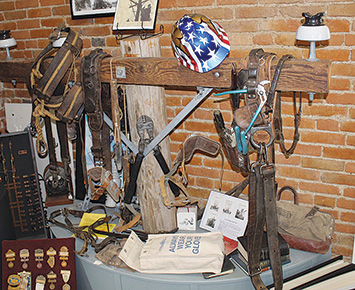
Belleville, IL – Every Saturday morning, Mike Hutch, Bob Poole and some of their friends gather to show visitors the essence of their very lives at the Belleville Labor and Industry Museum here.
These volunteer tour guides and longtime union members were there for much of the history to be seen at the museum, now in its third decade of service illuminating the past and showing how things are always changing, in our lives and in our work.
Hutch was an engineer for the Illinois Central and a member of the Brotherhood of Locomotive Engineers. Poole’s career was in the U.S. Navy.
The museum took a break for COVID-19 purposes but has now reopened on its familiar schedule, 10 a.m. to 2 p.m. every Saturday in the converted, historic Conrad Bornman house at 123 N. Church St., a few blocks north and east of the downtown square.
Much of the contents will be familiar to repeat visitors – great old photos, artifacts, cast-iron stoves, a giant rolling steam engine from 1895 – but there is also something new to be seen. Mary Harris “Mother Jones,” that indomitable, tireless campaigner for Labor causes and especially its people, is now featured – appropriately, considering how much influence she had on workers here and everywhere else.
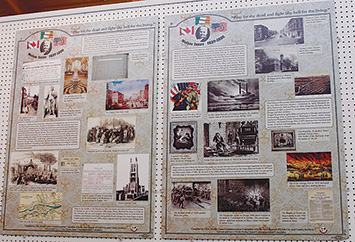
MOTHER JONES EXHIBIT
A set of large, informational boards with photos, art and text telling the story of her adventures, triumphs and causes, already seen at other locations in Illinois, has finally found its way to Belleville. The boards were prepared by the Cork Mother Jones Commemoration Committee, an organization of Mother Jones history buffs in Cork, Ireland, where she came from.
When the Mother Jones Museum in Mt. Olive, Ill., first opened a few years ago, these 12 boards were on prominent display to tell the story.
More recently, they were part of a Mother Jones display at a rest stop along Interstate 55 south of Springfield, along with a life-size photo of Mother Jones herself giving a quizzical sneer in a typically purple coat.
The Belleville museum found places for them. “It was in the Mother Jones museum, and then I think they made room for another display, and they brought a bunch of stuff down,” said Hutch. “She was a tough old gal, and she did a lot of good.”
SISTER & BROTHER
The Mother Jones display is in the annex building along with the great steam engine.
Another new addition is of more recent vintage – the light-proof, circular doorway used for many years to enter the darkroom at the Belleville News-Democrat, on display next to a similar-sized indoor telephone booth with lights that still work.
“It was probably in the lobby of some building. It’s not seen the elements,” noted Bob Poole as the tour continued.
“They’re sister and brother back there,” Hutch cracked.
After all these years of collecting, the best word to described this museum is probably “eclectic.” It tells about working in this region, but it tells just as much about living here, too.
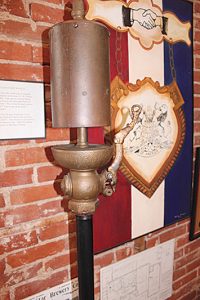
STAG BREWERY
The whole town used to keep track of the time by listening for the great steam whistle at the Stag Beer brewery, which sounded off at 7 and 8 a.m., noon, 12:30, 1 and 5 p.m. It was donated to the museum by the Stag Beer Retirees Club, along with decorative Stag bottles and buckets.
Nearby, visitors can see a large birds-eye-view lithograph of the brewery, on F Street near the jail. “It tells a little bit about the time,” Hutch said. “There’s a railroad, there are steam engines, and there’s a lot of horse wagons but no gasoline engines running around there – just horses and trains.”
THE STOCKYARDS
Old photos are pretty much everywhere in the museum, such as a display of the old stockyards along Exchange Avenue.
“In the summertime, the farmers all brought their stock in at night because of the heat,” said Hutch, who worked in a bank there as a young man. “The traffic was lined up all the way from the yards to St. Clair Avenue down past Collinsville Avenue.”
“There were taverns all along Exchange – it was a wonderful place.”
STOVES
Why stoves? Immigrants from Germany developed a substantial industry of factories that made stoves for use with either wood, coal or gas, and a dozen or so of these are in one of the major displays.
Some of the stoves feature enameling, a process of dipping stove pieces into colored, melted glass, resulting in bright, appealing stoves and utensils.
“The German people settled in this area, and that’s what they did for a living over in Europe, and they brought that with them,” Hutch said. Belleville is believed to be the first place in America where such enameling was used.
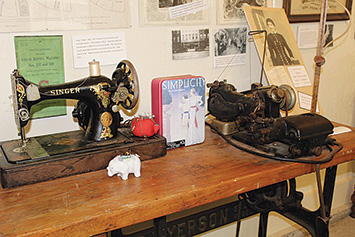
‘WOMEN’S WORK’
A newer section is called “Women’s Work After the Civil War,” featuring jobs typically held by women. The region was home to garment workers, with a dress factory, pants factory and shoe factories; a needle trade for repairs; and beauticians, including the place that operated an electric hair curler. Theater workers, teachers and public service workers all get their due.
The curler looks like something out of Dr. Frankenstein’s laboratory, with dozens of thick electrical wires connecting to the curlers. “I love this thing, because a lady had to sit in the chair, and they hooked up a wire to every curl she wanted in her hair,” Hutch said.
His enthusiasm for the ominous machine almost got him in trouble one time as he showed it to museum visitors and couldn’t resist crafting a little story.
“They were just ooh-ing and ah-ing – they’d never seen anything like it,” he said. “So I said, ‘A couple times when the electric chair at Menard went down, they borrowed this to do the job.’ You couldn’t believe the look I got!”
IN THE MINES
A display on coal mining features materials saved by tour guide Don Schmeder’s father – a lunch bucket, a carbide lamp, augurs for drilling holes, a ledger book listing chores and pay, and photos of some of the boys who used to work with the men, clearing bits of junk out of the accumulated coal. “That was one of the big things for Mother Jones – child labor,” Hutch noted.
GLASS WORK
Belleville Glassworks, eventually bought by August Busch, made bottles for soda, beer and whiskey, and these are on display, along with some more peculiar glass products called “whimsies.” These include turtles, chains, fishing float balls and, most whimsical, a complete walking cane made of glass.
“It wasn’t meant to be functional,” Hutch said. “Most of them got broken.”
PRINTING
Belleville used to be the home of dozens of newspapers, with different topics and languages, so the museum has created a room to show the equipment they used, unlike the computers of today.
It includes an actual press, much smaller than new ones but still pretty large.
“We got that out of a basement in south St. Louis,” Hutch said. “When we got down to the basement, we decided to go home and come back another day with more people. When we did, we went out of the door of the basement, turned around 90 degrees and there were steps going up to ground level. We got that thing out of there and nobody got killed, so I guess we did good.”
PATTERN MAKING
Once common, this meant molding molten iron in a box to make an infinity of metal forms, such as one for making fan blades that is on display. The work involved pouring in black sand and pounding it with mallets.
“It’s not something you learn about every day,” Poole said. “But that’s what they all did, and there were quite a few of them, and they all did pretty darn good.”
The downside was being around the molten iron and carrying it around. Poole’s own grandfather suffered lung damage from the work.
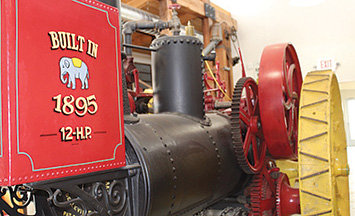
AND MUCH MORE . . .
The museum has dozens if not hundreds of topics, large and small. A few of them are:
- Trolleys, also known as streetcars, that would head toward all the nearby towns and rail stations.
- Farming equipment including an automated sheep shearer and a seed drill for planting.
- The self-propelled steam engine that came from the Henry Ford Museum and is the centerpiece of the annex.
- A belt and pulley system mounted in the annex that shows how factories used to power their equipment.
- A mechanical time clock from the old post office. “The employees would put their numbers in to check in,” Hutch explained. “There’s a big paper roll in there, and it would keep tabs on their checking in and out.”
- Pole climbing. Schmeder provided equipment for a display of equipment used by workers on electric poles – belts, gloves, helmets and other specialized gear.
COMING BACK TO LIFE
The museum has never been the kind of place to attract more than a few people or groups at a time. Then COVID-19 came, and it was shut down for more than a year. The return has been slow so far.
“We haven’t had many visitors,” Hutch said, promising that he is vaccinated and willing to wear a mask upon a request. “People are still wary, you know. We’re not getting near the people we used to. It’s going to take a while – they’re afraid.”
Hutch credits museum board president Bill Thurston and the entire Labor community for keeping the museum going and getting the annex built.
“Bill knew so many trades people that helped us out,” he said. “The Labor organizations all got behind us, and what we didn’t get in cash from them, we got in labor, from the electricians and the bricklayers and the concrete guys, and just everybody.”
HOW TO VISIT
To visit the Belleville Labor & Industry Museum, stop in between 10 a.m. and 2 p.m. on a Saturday at 123 N. Church St., Belleville. Park in the lot out back and walk around to the front. To arrange a visit at another time, call 618-222-9430 and leave a message.


My Nesbit heritage came here from Pennsylvania (Scotch/Irish) to work in the coal mines. Thank you for the tribute to the coal miners.